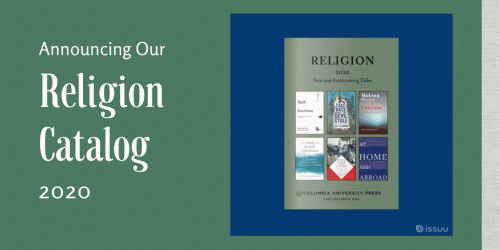The Environment as an Ethical Idea
By Anna M. Gade

“Anna M. Gade places her arguments within a rich exploration of historical and modern theoretical approaches to the environment and environmentalism. This book is theoretically sophisticated, lively, and interesting.”
~Marion Katz, author of Women in the Mosque: A History of Legal Thought and Social Practice
How might understandings of environmentalism and the environmental humanities shift by incorporating Islamic perspectives? This is the question Anna M. Gade explores in her book Muslim Environmentalisms: Religious and Social Foundations. In today’s AAR/SBL Annual Meetings Exhibit post, Gade introduces her new book and discusses environmentalism as an ethical idea.
• • • • • •
Rachel Carson’s masterpiece, Silent Spring, opens with a mystery. Her previous book, The Edge of the Sea, had begun with a short, reverent section on the mysterium of life on the shoreline before it launched into marine science. Silent Spring too begins with a stand-alone section, this time a “fable” that offers a mystery of death. Why don’t the birds sing anymore? Why are the domestic animals dying? Who cast the evil spell over the pastoral, settler landscape of America—was it some kind of witch? The moral of Silent Spring begins right here when the puzzle is solved: “The people had done it themselves.” The rest of Carson’s book, often said to have mobilized the environmental movement in the United States, presents the science of insecticides and public health, expressing the hidden alterity of environmental threat.
Spinning and then splitting off a tale about good, evil, and magic on the one hand, apart from solving the problems of science on the other (as Carson does in Silent Spring), is typical of interdisciplinary environmental studies overall. To me this bifurcation also reveals how a moral order underlies all facets of the field, from physical and biological sciences to social scientific and humanistic studies. Reuniting these disciplines by casting the environment as an ethical idea, including but not limited to the human commitments to “solve problems,” is a major contribution of Muslim Environmentalisms.
In the first chapter of Rule of Experts, titled “Can the Mosquito Speak?” (after Spivak), Timothy Mitchell puts a bug into the techno-political determinism of political ecology, writing about malaria in Egypt and the unintended effects of the insecticide DDT. Mitchell criticizes Karl Marx for writing that, although the bee does build an amazing hive, it is no architect because (unlike architects) its plans do not originate in imagination. Throughout Muslim Environmentalisms, from the front cover to the final page, I also introduce the imaginations of bugs—active, speaking, listening, and silent. Like Carson’s unheard birds or Mitchell’s Marxian mosquitoes, these metaphors keep it all very real ecologically; for example, the rapidly degrading diversity and declining abundance of insects on the planet have disastrous impacts on the food chains the sustain human life.
“The combination of moral and material modes is the foundational, ethical imagination of the environment.”
The combination of moral and material modes is the foundational, ethical imagination of the environment. This is clearly apparent in Islamic writings because Muslims originated so much of what we call the environmental sciences. Muslim legal traditions—which, like the Qur’an, lack a significant religion-versus-science dichotomy—also make the argument convincing. Features like this distinguish Muslim environmentalisms from post-Christian perspectives based on the Anglophone concept of nature. Finally, in the Islamic humanities, meaning-making metaphors are not tacked on to the main environmental story. For the environmental humanities and environmental studies, storytelling is increasingly the key to leveraging symbolism in order to mobilize commitment and concern (such as with climate change).
The Qur’an often mentions insects as well. For environmental humanities, the presence of insects in the Qur’an represents even more than the expansion of multispecies studies. The Qur’an makes frequent references to the tiniest of creatures, teaching that nothing, not the most minuscule nor the completely undetected, is insignificant from the standpoint of environmental epistemology. All “creatures” (makhluq) great and small, alive and dead, are furthermore shown to be on the same side of the absolute divide of Creator and creation in a Qur’anic sense. The book shows how this cancels out the environmental-ethical “problem” of anthropocentrism—an important and decolonial intervention. The crux of environmental ethics then becomes how it is that such relational creatures (like the Qur’an’s flies, ants, spiders, termites, and so on) also serve as environmental resources in both textual and ecological contexts.
“Bees, through the consequential conditions that Carson warned about, are also in real peril, just like us.“
The Qur’anic Bee illustrates the material reality of a metaphor that renders the environment inherently ethical. The book’s cover image by the contemporary Indian calligrapher Thoufeek Zakriya indicates verses of the Qur’an (Q. 16:68–69, from the chapter known as “The Bee,” Al-Nahl). The Bee is a “sign” (ayat) of Allah the Creator, through (for example) the marvelous healing honey that it produces. These same verses also turn to the mystery of the Bee’s own knowledge (such as how bees build their astounding hives). Here, incredibly, Allah speaks directly to the Bee: these nonhuman creatures receive divine “inspiration” (wahy) or possibly even divine revelation, just like humans. The environmental metaphor of the Bee becomes relationally real, as bees, like birds and all the other creatures in the Qur’an, are also “communities like you” (Q. 6:38). Bees, through the consequential conditions that Carson warned about, are also in real peril, just like us. The rate of extinction of insects is now estimated to be eight times greater than that of birds, reptiles, and mammals, with almost half of the world’s insect species now in decline and one-third of them holding endangered status.
DDT was meant to kill. In Muslim Environmentalisms, I tell a story about alternative pest management from the classical essayist Al-Jahiz (d. 869). He explains how he carried out an experiment in controlling the biting mosquitoes that were bothering him. After testing empirical hypotheses, he concluded that he should allow other household bugs just to prey on the mosquitoes, and then open the window so they would eventually fly away outside. He quips, “Our remedy lies in keeping near to us what we used to keep at a distance.” The environment already has, and always will have, a moral to the story.
Save 20 percent on our conference titles on display when you use coupon code AAR20 at checkout from our website by December 31, 2020.







